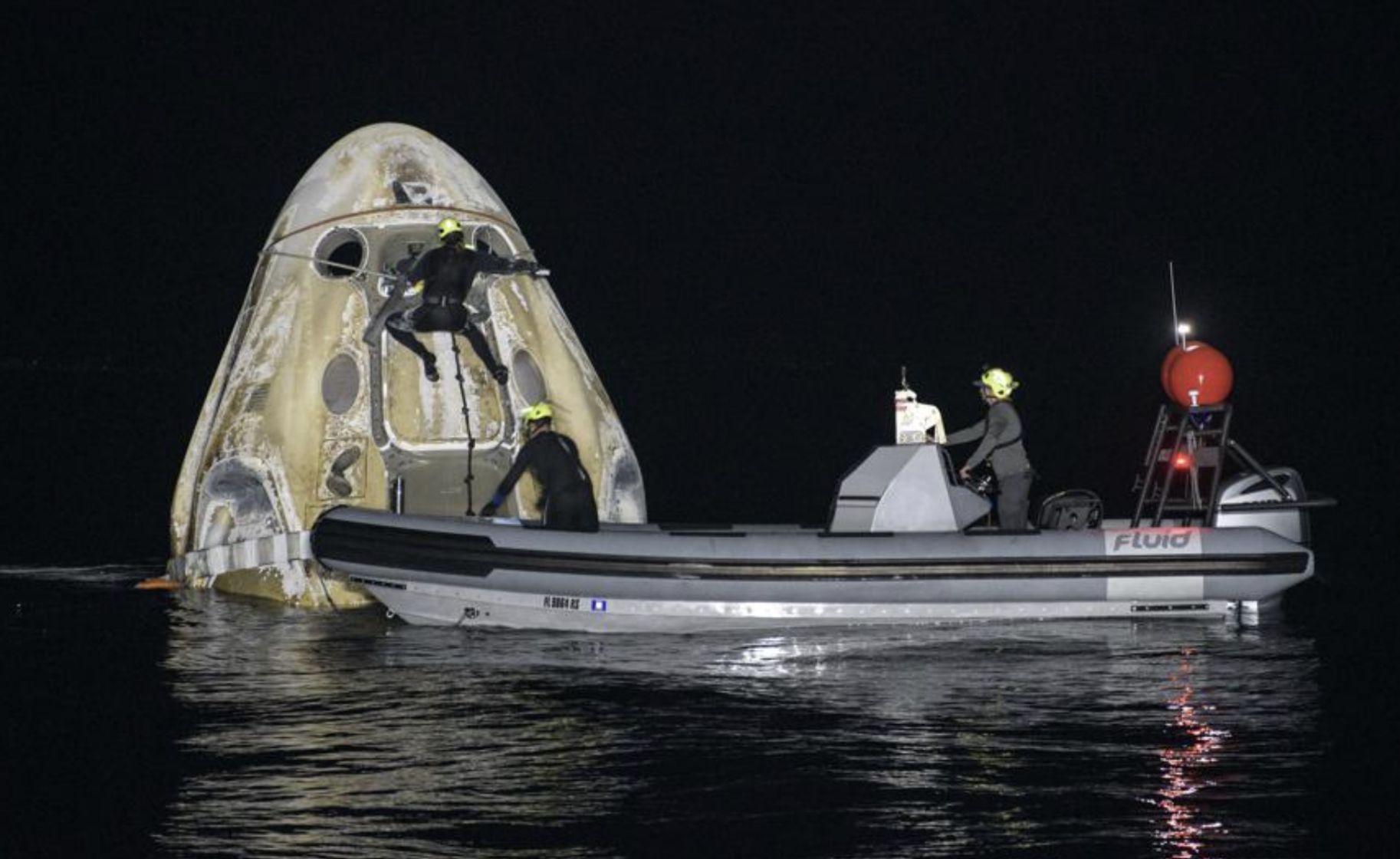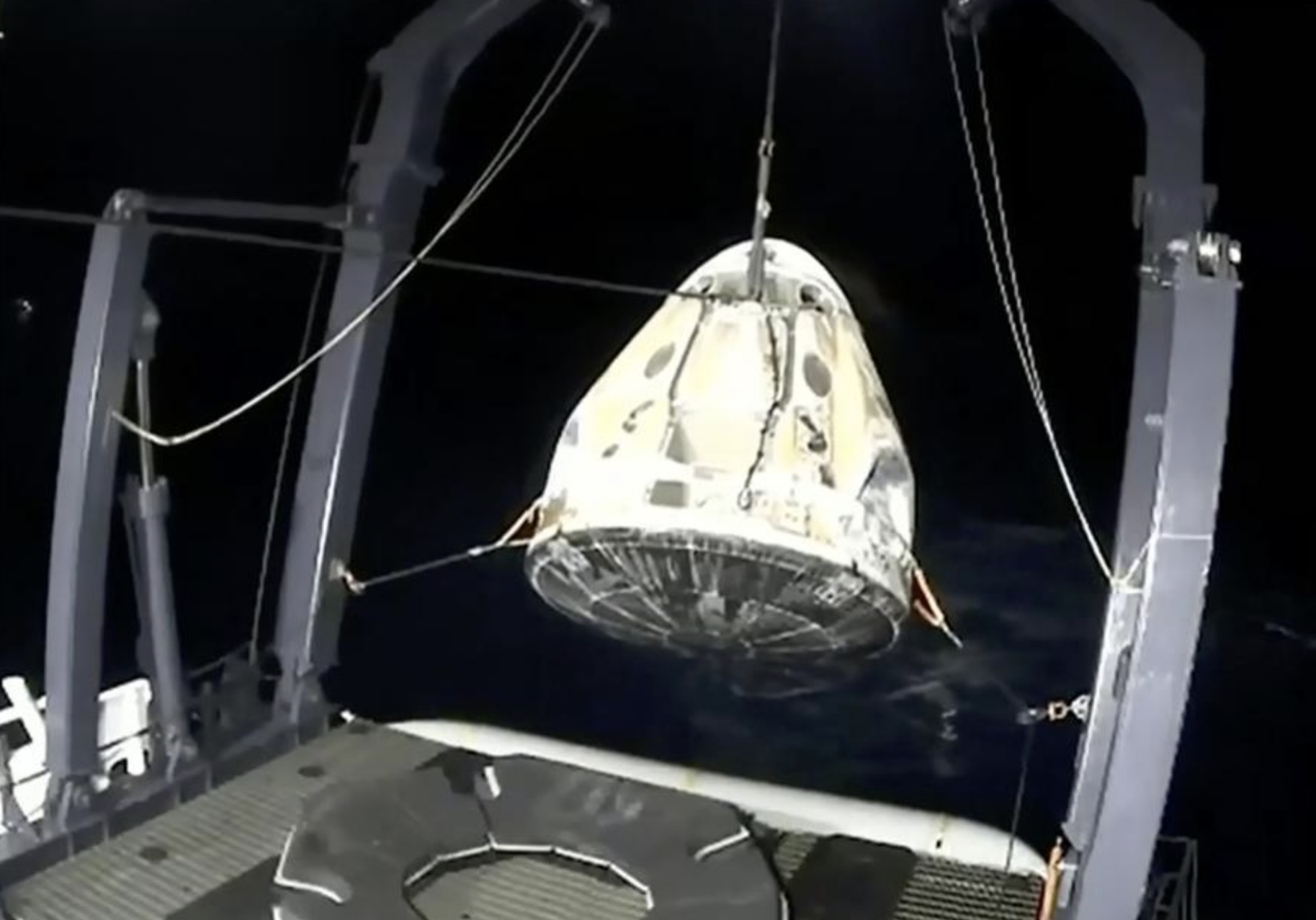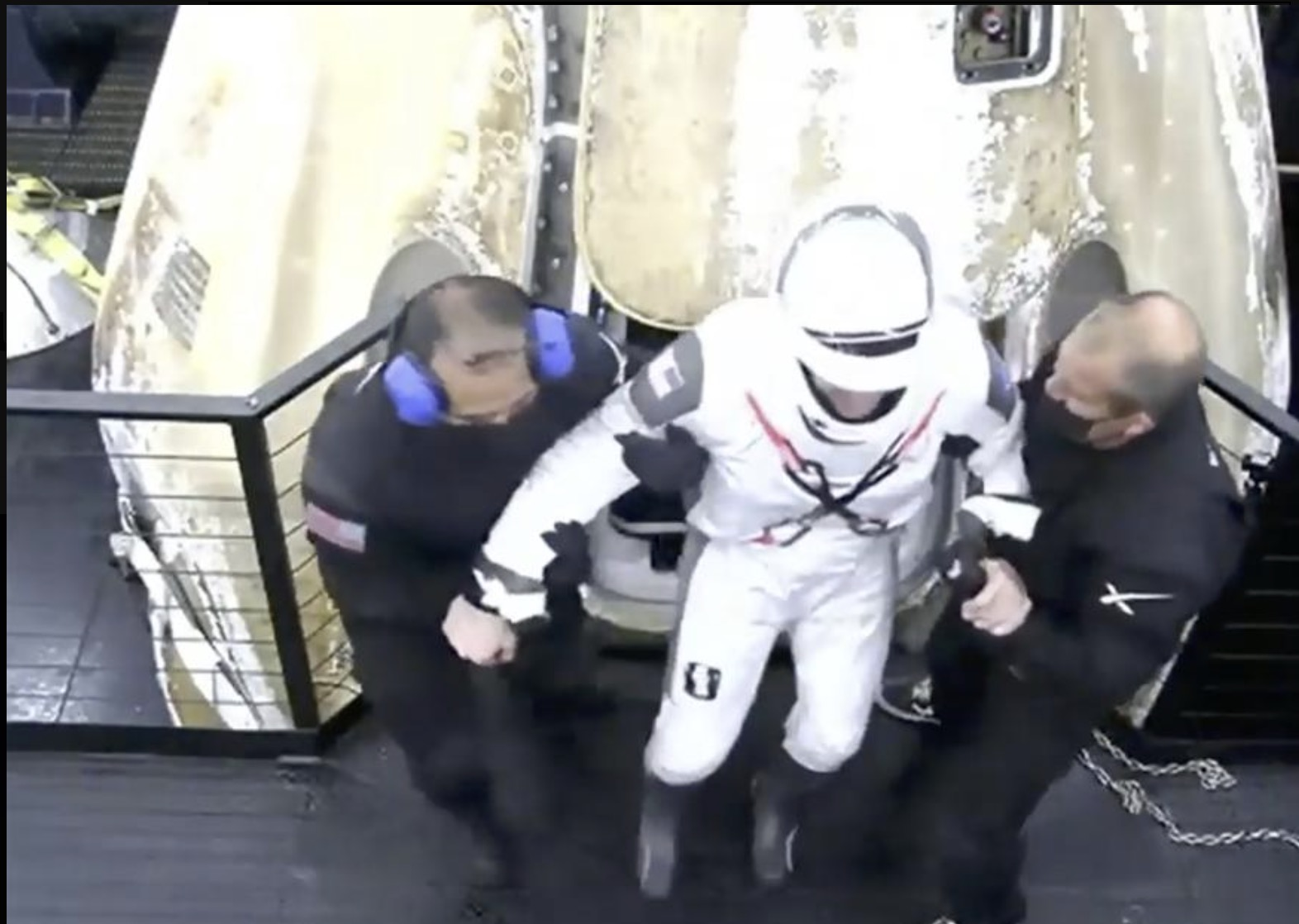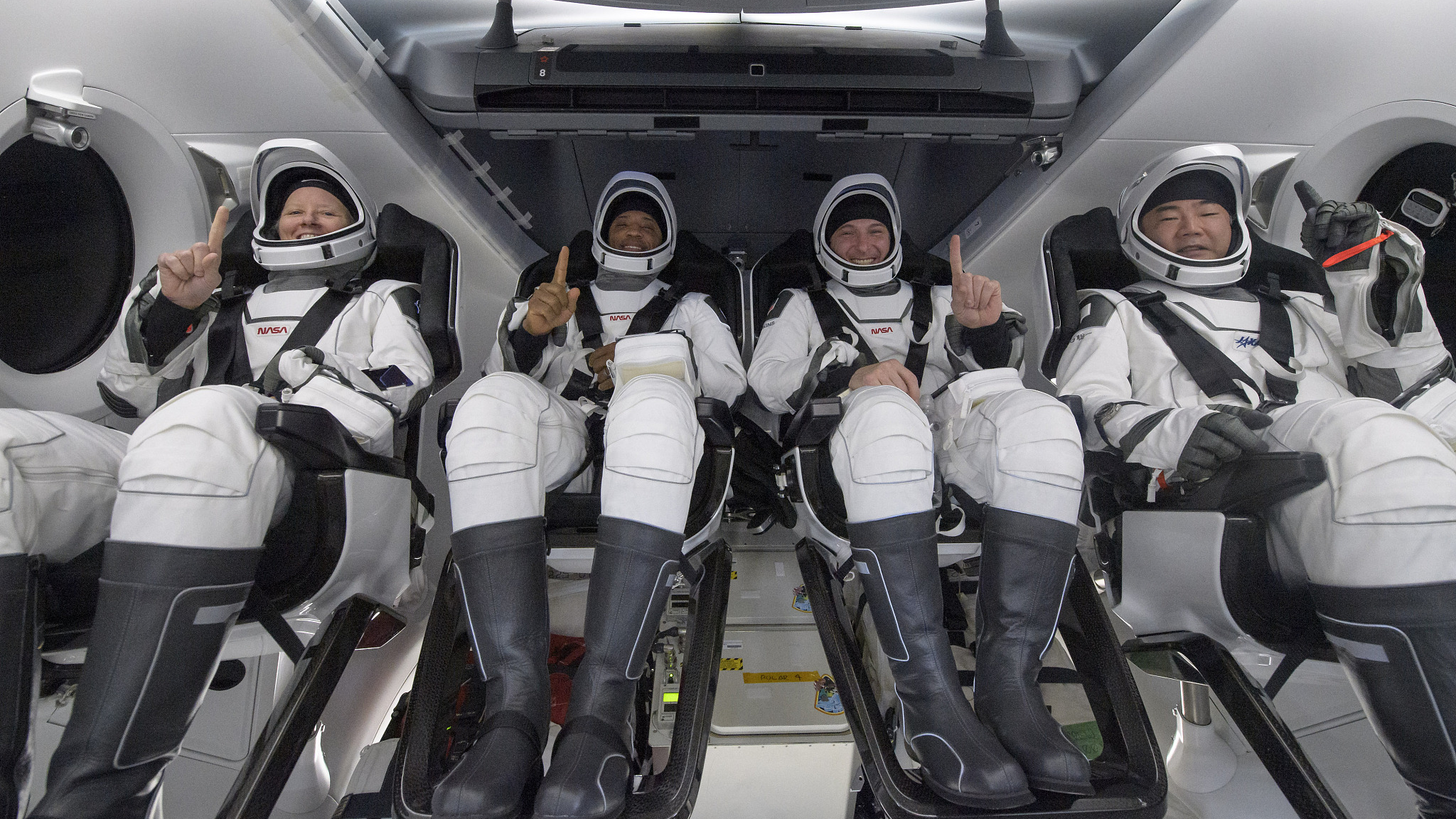
The SpaceX Dragon capsule floats after landing in the Gulf of Mexico near the Florida Panhandle, U.S., May 2, 2021. /NASA
The SpaceX Dragon capsule floats after landing in the Gulf of Mexico near the Florida Panhandle, U.S., May 2, 2021. /NASA

The SpaceX Dragon capsule is retrieved from the Gulf of Mexico near the Florida Panhandle, U.S., May 2, 2021. /NASA
The SpaceX Dragon capsule is retrieved from the Gulf of Mexico near the Florida Panhandle, U.S., May 2, 2021. /NASA

Commander Mike Hopkins egresses the SpaceX Dragon capsule after being retrieved from the Gulf of Mexico near the Florida Panhandle, U.S., May 2, 2021. /NASA
Commander Mike Hopkins egresses the SpaceX Dragon capsule after being retrieved from the Gulf of Mexico near the Florida Panhandle, U.S., May 2, 2021. /NASA
Four Crew-1 astronauts aboard a SpaceX aircraft returned from the International Space Station (ISS) on Sunday, marking the first nighttime splashdown by a U.S. crew since the Apollo 8 moonshot 50 years ago, said the U.S. National Aeronautics and Space Administration (NASA).
The crew reported they were feeling well after their return following a nearly six-month mission at the ISS.
The capsule splashed down at 02:56 EDT (06:56 GMT) in the dark in the Gulf of Mexico off Panama City after a 6.5-hour flight from the ISS, night-vision images relayed by NASA's WB-57 high-altitude research aircraft showed.
Teams aboard the Go Navigator recovery ship retrieved the capsule and hoisted it onto the deck about half an hour later. It was the first nighttime splashdown for NASA since the crew of Apollo 8 arrived in the Pacific Ocean on December 27, 1968.
Commander Michael Hopkins was the first to emerge after the hatch was opened, doing a little jig as he set foot on deck, followed shortly after by fellow NASA astronaut Victor Glover.
"On behalf of Crew-1 and our families, we just want to say thank you. It's amazing what can be accomplished when people come together. You all are changing the world. Congratulations. It's great to be back," Hopkins said in a NASA tweet.
NASA astronaut Shannon Walker and Japan's Soichi Noguchi were the other two onboard.
"Welcome home Victor, Michael, Shannon, and Soichi, and congratulations to the teams at NASA and SpaceX who worked so hard to ensure their safe and successful splashdown," said new NASA administrator Bill Nelson.
"We've accomplished another incredible spaceflight for America and our commercial and international partners. Safe, reliable transportation to the International Space Station is exactly the vision that NASA had when the agency embarked on the commercial crew program."
Travel of 71.2 million miles

Four astronauts of NASA's SpaceX Crew-1 mission are inside the SpaceX capsule after landing in the Gulf of Mexico off the coast of Panama City, Florida, U.S., May 2, 2021. /CFP
Four astronauts of NASA's SpaceX Crew-1 mission are inside the SpaceX capsule after landing in the Gulf of Mexico off the coast of Panama City, Florida, U.S., May 2, 2021. /CFP
The four astronauts went to space last November as the crew on the first fully operational mission to the ISS aboard a vehicle made by Elon Musk's SpaceX, which has become NASA's favored commercial transportation partner.
They traveled 71.2 million miles (114.6 million kilometers) during their 168 days in orbit (including 167 days aboard the space station), NASA said. After medical checks, the four astronauts will be flown by helicopter to Pensacola to board a plane for Houston to be reunited with their friends and family.
"The reports are all four crew members are in great shape and in great spirits and doing really well," NASA chief flight director Holly Ridings said at a post-spashdown news briefing. "Really just a great day. It's not very often you get to wake up on the space station and go to sleep in Houston," she said.
Seven astronauts remained on the ISS, including a new crew of four who arrived on a different SpaceX craft last week.
"Thanks for your hospitality," Hopkins said earlier as the capsule undocked from the space station for its return journey. "We'll see you back on Earth."
Prior to that, two American astronauts made a test mission to the ISS in May and stayed for two months. That was the first launch to the ISS from U.S. soil since the end of the Space Shuttle program in 2011. It was also the first crewed mission run by a private company, as opposed to NASA. Until then U.S. astronauts had caught rides to the ISS aboard Russian spacecraft.
NASA's Commercial Crew Program
NASA turned to private companies to service the space station after the shuttle fleet retired in 2011. SpaceX began supply runs in 2012 and, last May, launched its first crew, ending NASA's reliance on Russia for astronaut transport.
The Crew-1 mission is just the first part of NASA's Commercial Crew Program, which has worked with the U.S. aerospace industry to launch astronauts on American rockets and spacecraft from American soil to the space station.
NASA's SpaceX Crew-1 mission was launched on November 15, 2020 on a Falcon 9 rocket from the agency's Kennedy Space Center in Florida. Throughout their space station mission, while aboard the orbiting laboratory, the four Crew-1 astronauts contributed to scientific investigations and technology demonstrations as well as spacewalks and public engagement events.
The Crew-2 astronauts embarked on their journey on April 23 and will live and work at the ISS for around six months as the astronauts are scheduled to return to Earth on October 31, about a week after welcoming their Crew-3 colleagues to the orbiting outpost no earlier than October 23.
(With inputs from AFP, AP)

